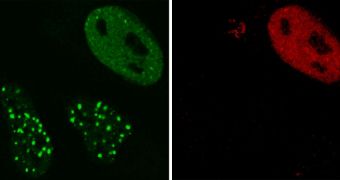Researchers at the La Jolla, California-based Salk Institute for Biological Studies have recently determined one of the key mechanisms the herpes simplex virus (HSV) uses to keep cells unaware of the fact that it has infected them. This “covert” approach to infecting the human body is very efficient, the group says, as evidenced by the fact that getting rid of the viral agent is very difficult. More details of their study will appear soon, in an upcoming issue of The EMBO Journal. The Salk team believes that the findings may also hold some relevance for other viruses as well, as this mechanism of infection could be widespread among microorganisms.
Like all viral agents, HSV needs to be able to “hijack” a host cell in order to produce more copies of itself, or multiply. However, before this objective can be achieved, it also needs to evade the intricate defense mechanisms that the cells have set in place to prevent precisely this type of contamination. “We found that detection of the viral DNA by the host cell is an important barrier that the virus must overcome in order to achieve its goal. For this purpose, it brings along a protein that shuts down the normal cellular responses that would otherwise recognize and silence it,” Matthew Weitzman, PhD, explains the basis of the HSV approach. He is an associate professor in the Salk Laboratory of Genetics, and also the leader of the team that conducted the new investigation.
The team hypothesized that the infection mechanism might somehow be connected to the cellular molecules that were in charge of repairing damaged DNA within the cell. These components always scan the inside of the cell, looking for what one may term “unusual bits and pieces of DNA.” “We reasoned that viral DNA would be recognized by the cell's DNA repair machinery and that the virus must somehow manipulate the cell's response to this foreign DNA,” Weitzman reveals. Their idea appears to have been verified in practical experiments. In healthy cells, damaged DNA immediately prompted a response reaction from the repair proteins.
Conversely, in cells that had been artificially implanted with HSV, the sensor proteins in charge with repairing the genetic material appeared to malfunction. Weitzman and his group therefore concluded that the herpes virus was able to silence the naturally occurring, DNA-damage response of sensor proteins, as this prevented its own genetic signature from being detected. Upon further analysis of these cellular events, it was determined that the viral protein ICP0 was directly responsible for disrupting the action of two very important cellular “guards,” the proteins RNF8 and RNF168, in one fell swoop.
“We found that HSV targets the mark that is required to keep DNA damage sensors at damage sites. We now think that HSV deliberately removes this mark so that the virus can infect cells without any trouble from its new host,” Salk postdoctoral researcher Caroline Lilley, PhD, also the first author of the research, says. “By identifying how HSV dismantles the host's defense systems, we are shown the key steps, not only in viral infections, but also in the human DNA damage response,” Weitzman concludes.

 14 DAY TRIAL //
14 DAY TRIAL //